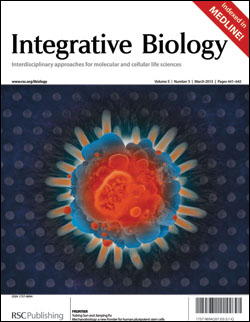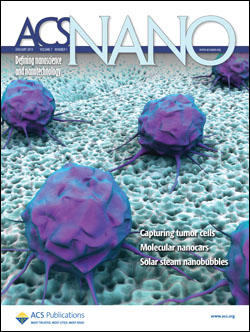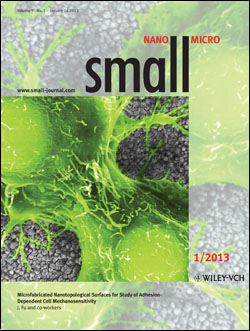Assistant Professor Jianping Fu’s research has been featured as the cover story of Integrative Biology, ACS Nano, and Small.
Front cover story for 2013, Vol. 5, Issue 3 of Integrative Biology
Integrative Biology is a multi- and inter-disciplinary journal for research using experimental or computational quantitative technologies to characterise biological systems at the molecular, cellular, tissue and population levels.
 Description of research: A false-color scanning electron microscopy image showing human embryonic stem cells seeded on a regular array of elastomeric microposts. In this Frontier review, we have highlighted the recent excitement to study mechano-sensitive and -responsive behaviors of human embryonic stem cells. We have further speculated on how mechanobiology research can contribute to understanding of the unique sensitivity of human embryonic stem cells to their culture conditions.
Description of research: A false-color scanning electron microscopy image showing human embryonic stem cells seeded on a regular array of elastomeric microposts. In this Frontier review, we have highlighted the recent excitement to study mechano-sensitive and -responsive behaviors of human embryonic stem cells. We have further speculated on how mechanobiology research can contribute to understanding of the unique sensitivity of human embryonic stem cells to their culture conditions.
Front cover story for 2013, Vol. 7, Issue 1 of ACS Nano
ACS Nano is an international forum for the communication of comprehensive articles on nanoscience and nanotechnology research at the interfaces of chemistry, biology, materials science, physics, and engineering.

Description of research: Schematic representation of random nanoroughness on glass surfaces generated using reactive ion etching (RIE) and its utility for efficient capture of cancer cells from blood specimens without using capture antibodies. The method utilizes the differential adhesion of cancer cells to nanorough surfaces when compared to normal blood cells and thus does not depend on the physical size or surface protein expression of cancer cells.
Front cover story for 2013, Vol. 9, Issue 1 of Small
Small is a multidisciplinary journal covering a broad spectrum of topics at the nano- and microscale at the interface of materials science, chemistry, physics, engineering, medicine, and biology.

Description of research: A false-color scanning electron microscopy image showing adhesive cells on a nanotopographic surface. Nanoscale roughness can be precisely controlled and spatially patterned on glass surfaces with a microfabrication method using photolithography and reactive ion etching. This technique is used to understand adhesion-dependent cell mechanosensitivity to nanotopological cues. Nanoscale topological features provide a potent regulatory signal over a diverse range of NIH/3T3 fibroblast behaviors, including cell morphology, adhesion, proliferation, and migration. The topological sensing of NIH/3T3 fibroblasts includes feedback regulation and mechanical-biochemical integration.
Fu is also the leader of the Integrated Biosystems and Biomechanics Lab (IBBL).
